News & Events in Belarus
Why Lukashenko calls Mound of Glory sacred place
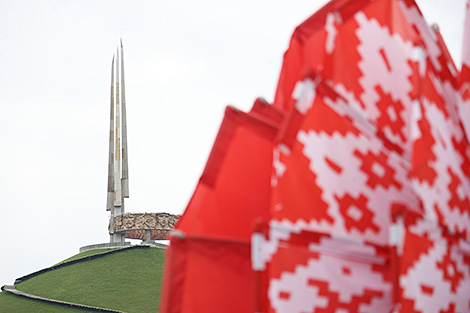
An archive photo
The Byelorussian offensive operation Bagration, one of the largest military operations in the history of mankind, ended 80 years ago. A majestic Mound of Glory was built near Minsk in its honor. The place was chosen on purpose: it was in these places that the Soviet army surrounded 105,000-strong group of Nazi troops and destroyed it. The battle went down in history as the "Minsk cauldron". The allies in the anti-Hitler coalition did not believe in such a brilliant victory of the Soviet army. However, these doubts were quickly dispelled when almost 60,000 German soldiers and officers who had been captured during Operation Bagration were paraded in Moscow.
The construction of the Mound of Glory began in November 1967 and immediately became a national project. Thousands of people flocked to Minsk from all over the big country bringing a handful of soil from the places of military glory in memory of those who gave their lives for a peaceful future. In this episode, we will tell you why the famous Belarusian memorial is unique? How did the wife of the head of the BSSR help to "move" the Mound of Glory and whose faces are depicted on top of the monument? How the memorial almost fell into disrepair and why did Aleksandr Lukashenko demand to restore this symbol of the unity of all Soviet peoples?
Why did they decide to build the Mound of Glory in Belarus
482 steps of memory... The Mound of Glory is truly a special monument for Belarus. The decision on it was made in August 1966 when the Bureau of the Central Committee of the Communist Party of the BSSR approved a proposal by the Minsk Oblast Party Committee to build a monument in Minsk Oblast. According to the idea, it was to mark the victorious Operation Bagration that destroyed Army Group Center, the most powerful group of forces of Nazi Germany.
It was decided to place the Mound of Glory not far from the Belarusian capital, next to the Minsk-Moscow highway. As we have already noted, the fiercest battles took place in this area, the occupiers were literally boiling in a cauldron. They say that the place for the construction of the memorial was chosen by First Secretary of the Central Committee of the Communist Party of the BSSR Piotr Masherov. Or rather, his wife. Initially, the monument was to be built on the other side of the highway. But Piotr Masherov took a drive along the Minsk-Moscow highway to see how the monument would look like from the distance. It turned out that it was "slipping" off the highway. A decision was made to move the monument to the opposite side. Later, Masherov's daughter Natalia clarified that it was the wife of Piotr Masherov, Polina, who spotted the unfortunate location of the Mound of Glory on that trip.

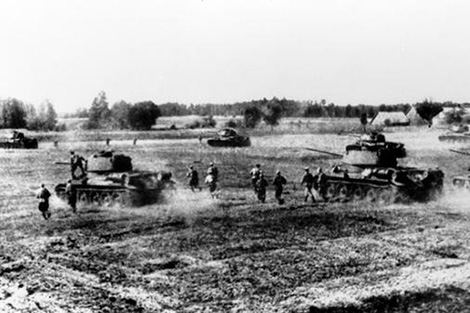
Construction of the Mound of Glory
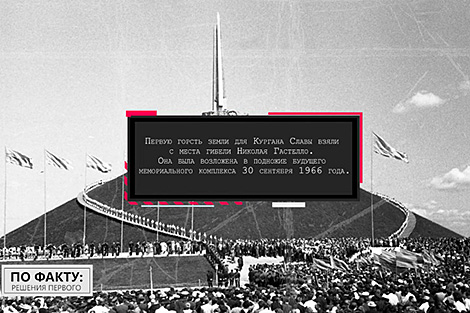
The project broke ground on 30 September 1966. The ceremony was attended by representatives of the hero cities of Moscow, Leningrad, Volgograd, Sevastopol, Odessa, Kiev, and Brest Hero Fortress. The memorial plate has the inscription that reads: "The Mound of Glory honors the Soviet Army that in 1944 defeated the largest group of Hitler's troops with the active participation of partisans and involving the 1st, 2nd, 3rd Byelorussian Fronts and the 1stBaltic Front. During the Byelorussian offensive operation, Soviet troops completely destroyed 17 and defeated 50 enemy divisions.”

The construction of the Mound of Glory began in November 1967. Soil was delivered here from Belarusian cities and villages, hero cities of the Soviet Union and other memorable places associated with the heroic deeds of the Soviet people during the Great Patriotic War. Only after the pilgrimage of those wishing to add a handful of soil stopped, excavators and trucks began to work here, and the mound rose to 35 meters (the height of a 12-story building). The total height of the memorial exceeds 70 meters.
"The memory of the war heroes is embodied in this monument. The Mound of Glory was built on the site of the landmark battles. The mound was literally built by the hands of thousands of people who witnessed the war, who remembered their fallen comrades, mourned the lost relatives. During a year they brought handfuls of soil from the hero cities, the places of the partisan resistance, the soil that absorbed the tears of mothers, wives and children of fallen soldiers, the pain of loss of millions of lives. Again, imagine the state of mind of the people who came by thousands to Belarus, the holy land of Victory, to make this Mound. It really embodies the tears and mood of millions of Soviet people. It reflects the dreams, aspirations, sentiments. There is probably no more sacred man-made place as this one today,” Aleksandr Lukashenko said at the solemn event at the Mound of Glory memorial several years ago.
Back then he noted that the Mound of Glory is a sacred symbol. A symbol of our independence and freedom. “We should be proud that there is not even a small monument in Belarus unkempt, unattended. Even Russians, knowing this, highly appreciate the attitude of Belarusians to the monuments of the Great Patriotic War. There are thousands, thousands and thousands of them on our land. Someone is proud of their wealth in the form of natural gas, oil, gold, metals, but there is no more valuable and expensive gift than Great Victory. Why is it very dear to us? Because Belarus paid for it with every third life. As the great Lenin once said, we must ask ourselves the question: what legacy are we rejecting? Those who want to forget Victory are simply madmen. They don't think about what we can lose,” the Belarusian leader noted.
Architectural solutions
For the stability of the structure during construction, a pillar foundation was laid, going to a depth of 30m. Two stairs (241 steps each) around the mound lead to the observation deck at the top of the mound. The bayonets on the top of the mound symbolize the fronts that participated in the liberation of Belarus: the 1st, 2nd, 3rd Byelorussian Fronts and the 1st Baltic Front.

A wide stone ring has an inscription on the inner side: "Hail to the Soviet Army, the Liberation Army!" and mosaic images of the Orders of the Patriotic War and Glory. On the outer surface of the ring there are bas-reliefs symbolizing the generalized images of the defenders of the Motherland: a young partisan, an old partisan, a pilot, a sailor, a tankman, young and old infantrymen.
The monument was unveiled on 5 July 1969 to mark the 25th anniversary of the liberation of Belarus from the Nazis. The simple and majestic Mound of Glory harmoniously fits into the surrounding landscape and is clearly visible from afar from all sides. The authors of the monument, sculptor Andrei Bembel and architect Oleg Stakhovich, were presented with the State Award of the BSSR in 1970 for the great idea and artistic solution.
Why did the Mound of Glory necessitate reconstruction?
How could such a memorial fall into disrepair then? After all, it was built for centuries and with a firm belief that the great country, which defeated the most terrible dark force in the history of mankind, would only grow stronger and prosper.
At the turn of the 2000s Aleksandr Lukashenko said that those who built the Mound could not have imagined that everything would turn out different, that the Soviet Union would cease to exist. The Soviet soldier would never justify the failure to defense the Soviet Motherland in peacetime.
The Belarusian president emphasized: “The collapse of the Soviet Union created an enormous devastation in minds. The devastation inflicted from the outside and fiercely heated up by nationalists from inside the country. Insolent nationalists manipulated both the government and the parliament of the country. Everything related to the Soviet Union, including the great Victory and the Victors, was rejected. Here, in Belarus, in the partisan country, nationalists tried to present partisans as bandits and German accomplices as fighters for the national idea. In this environment, the monuments of the Great Patriotic War, including the Mound of Glory, were falling into disrepair.”
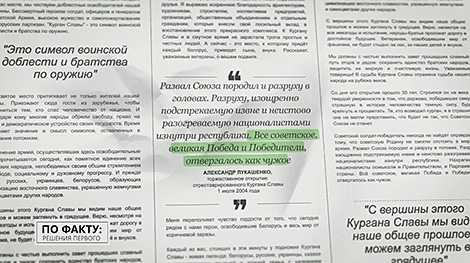
In 2003, the head of state supported the initiative by the Federation of Trade Unions of Belarus (FTUB) to take patronage over the Mound of Glory. The first large-scale renovation of the memorial was carried out that year. The surrounding area was landscaped, administrative buildings and engineering networks repaired, and a new irrigation system was installed. The second phase saw the upper decorative ring and the steps repaired and a museum of military hardware opened. In the spring of 2004, a park named after the 60th anniversary of the Victory in the Great Patriotic War was laid out around the monument.
At the inauguration of the restored Mound of Glory the head of state noted that the Mound of Glory is a symbol of military valor and brotherhood in arms. “Time highlights the meaning and essence of the symbols left over to use by our ancestors. The armies that joined here for liberation battles is seen today as a memorable unity of all Soviet peoples, invincible by their common desire for freedom, social and spiritual progress. And first of all, Russians, Ukrainians, Belarusians, who form the civilization of the Eastern Slavs, decorated with pearls and gems of other peoples. From the top of this Mound of Glory we can see our common past and can look into the future. I believe that despite all hardships and trials, our brotherly nations will pave the way to a worthy future. The war veterans who liberated the world from fascism will not feel ashamed of us, our children and grandchildren. We must honorably fulfill the promise of our glorious fathers and grandfathers to preserve the unity of brotherly peoples, to protect their peaceful and happy life,” Aleksandr Lukashenko said.
The renovated Mound of Glory re-opened on 1 July 2004. The official ceremony was attended by the presidents of Belarus, Russia and Ukraine. The memorial complex acquired its modern look in May 2015 thanks to the efforts of trade unions and volunteers.
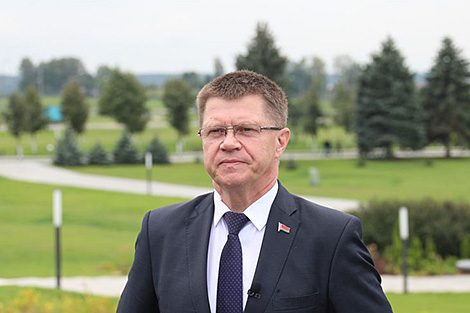
“The monument had not undergone major repairs since its inauguration. First major repairs were carried out by the Federation of Trade Unions in 2003. The effort involved not only the Federation of Trade Unions. A call was made to the entire nation. A lot of people pitched in, either by donating money or doing some work. Since then, routine maintenance has been carried out, including several major repair rounds. Also, on the initiative of the Federation of Trade Unions, an open-air museum was opened on the lower platform. The display of military hardware from the Great Patriotic War arouses great interest among visitors: both Belarusian and foreign tourists,” Chairman of the Federation of Trade Unions of Belarus Yuri Senko said.
In 2017, Aleksandr Lukashenko bestowed Spiritual Revival Award upon the Federation of Trade Unions. A number of the FTUB initiatives were highly recognized, with the reconstruction of the Mound of Glory being a major large-scale project.
Why does Lukashenko keep the reconstruction of the Mound of Glory under personal control?
In 2023 the memorial complex drew about 110,000 visitors. The authorities have been tasked with doubling these numbers. The decision was taken to carry out another phase of the reconstruction in 2023. Aleksandr Lukashenko keeps these issues under his personal control.
In August, Minsk Oblast Governor Aleksandr Turchin reported to the president on the stages of financing construction and installation works and plans for their completion. According to him, one of the solutions under discussion is the installation of railings along the stairs leading to the top of the Mound. On the one hand, their presence would secure safe ascending, but on the other hand, the architecture of the monument may suffer. In addition, it will require additional funding. This issue is still to be worked out in detail.
“It is not even about money. We must not spoil the original look,” Aleksandr Lukashenko emphasized. “There is absolutely no need for frills here.”
Yuri Senko stated that the Mound of Glory is a special monument for Belarus. Not only in terms of architectural features. Firstly, it was built by ordinary people who came here from different parts of the country. And secondly, the monument has a special ideological component.
“It carries the memory of hard times for our country. But at the same time it celebrates the Victory, the liberation of Belarus. It is associated more with joyful events for our people, and we must maintain it in proper condition. There are a number of plans, the head of state has been submitted a proposal to create a museum here. The president instructed to think about it, but not to distort the very meaning of the monument. Therefore, we are thinking about this issue,” the FTUB leader said.
Here is one more observation. When you climb up the Mound of Glory, you get a great view of spacious and well-maintained fields. You immediately realize how great it is to live in peace. The words of the Belarusian president come to mind: it is better to engage in harvesting battles in the fields than in combat battles at the front. Very true!









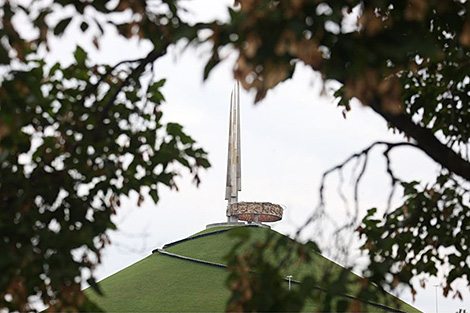

 print version
print version make home page
make home page add to bookmarks
add to bookmarks

